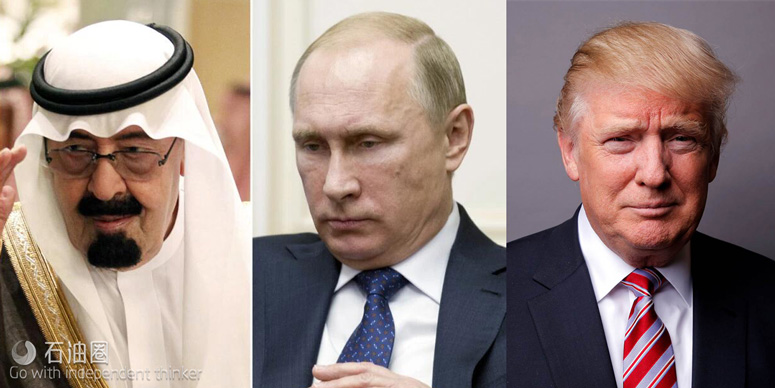President Donald Trump’s visit to Saudi Arabia last week was full of pageantry, defense agreements and rhetoric extolling the decades-long Saudi-US alignment. Among the various strategic interests bringing Riyadh and Washington together is opposition to Russia, a revisionist power which Saudi Arabia has opposed in Syria and elsewhere.
Allegations regarding Trump’s meeting with Russia’s foreign minister notwithstanding, the Saudis believe the U.S. remains determined to support its stance against Russia, which backs Iran, Riyadh’s major regional competitor, and has attempted in recent years to expand its influence and reach in the Middle East.
Yet what has brought Russia and Riyadh together is unity over production cuts,, widely expected to be extended at this week’s OPEC conference in Vienna. This complicates the geopolitics and presents the possibility of closer ties between Russia and Saudi Arabia, both of whom have been affected by low prices and the surge of American oil production.
Last week, announcements from Russia and Saudi Arabia rescued the price from its mid-$40s doldrums, facilitating a 5 percent price rally amid positive talk that OPEC and non-OPEC production cuts would remain in place for the remainder of the year and even continue into 2018 if prices warranted it. Kuwait joined the two countries, agreeing to cut production into the first quarter of next year if necessary. There is now a general consensus that when OPEC meets this week in Vienna, the members will agree to an extension of cuts, possibly into 2018.
As Bloomberg points out, the alliance between Moscow and Riyadh over oil is a marriage of convenience. Both rely on oil exports and have seen state finances suffer since the 2014 price crash.
It also isn’t the first time the two countries coordinated on production: for five years before 2004, Russia cooperated with Saudi Arabia and the rest of OPEC to keep production steady amidst a period of global economic uncertainty following the Asian financial crisis, dot-com bubble and 2001-2002 American economic recession.
Compliance with the cuts put in place in January 2017 came quickly in Saudi Arabia, which reduced production past the agreed-upon level almost immediately. Russia, however, took almost four months to cut 600,000 bpd and remained cagey as to whether it would continue the cuts.
For Riyadh, the current slump in prices has complicated Vision 2030, the plan to shift the Saudi economy away from oil exports and towards greater diversity. The plan includes a partial IPO of Saudi Aramco, the state oil company that may be worth as much as $2 trillion. What the company is actually worth depends in part upon the value of Saudi oil exports in the future and the ability of country’s oil to compete with new production from the United States. Ensuring a successful IPO next year is a major goal for the Saudi government as it plans its economic future.
Oil also serves as the chief Saudi means to influence Russia, a state which is also vulnerable to changes in the market. A weakened currency and two-year recession resulted from the fall in oil prices, though the Russian economy is in recovery and should post a 1.4 percent growth this year. Saudi Arabia undoubtedly hopes that cooperation over oil will lead to a dialogue on other issues, most notably Russia’s support for Syrian president Bashar al-Assad and Russia’s strong backing of Iran, Riyadh’s chief regional antagonist.
Saudi deputy crown prince and defense minister Mohammed bin Salman has stated that the chief Saudi concern with Russia is its connection to Tehran. Riyadh has in recent years increased its level of regional interventionism, supplying money and arms to Syrian rebels aligned against the Assad regime in Syria and launching an armed intervention into the civil war in Yemen. Much of this has come as a result of a perceived American realignment under President Obama and a resurgent Iran, which Crown Prince Mohammed sees as its number one national security threat. Reducing Russia’s level of support for Tehran and aligning its interests with Saudi Arabia, at least over oil, is a factor in Saudi foreign policy.
Trump’s visit has served to soothe Saudi concerns that his presidency would weaken existing ties between Washington and the Persian Gulf. As a candidate, Trump expressed skepticism regarding American interventions abroad and even speculated that it was time for the US role in the Middle East to end. The splashy visit, accompanied with a historically-large $110 billion arms deal, has cemented the traditional Riyadh-Washington axis and assured the Saudis, as well as the rest of the Gulf, that Trump has their best interests in mind.
In diplomatic terms, the alliance with the United States is of major importance to Saudi Arabia. Yet competition with surging American production has emerged as a key challenge to the oil kingdom as it attempts to pivot its economy away from oil exports. Confrontation with Iran is the other piece of the puzzle, and while President Trump has made it clear he does not share the relative flexibility of the Obama Administration over relations with Tehran, it is still in Saudi Arabian interest to see Iran weakened by siphoning off its support from Russia. A close alliance over oil production cuts and cooperation going into 2018 could be a way to achieve that goal.
For oil traders, the relationship between Russia and Saudi Arabia is the crucial one to watch in the run-up to this week’s OPEC conference.


 石油圈
石油圈
